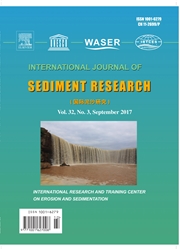

 中文摘要:
中文摘要:
实验的二十跑被执行调查非平衡运输分级并且在一条降级的隧道的一致的床负担沉积。排序得好的石子和沙被采用与不同石子 / 沙内容填写四种沉积床,即,一致 100% 石子床,一致 100% 沙床,和二张分级的沉积床分别地与 53% 石子以及 22% 石子和 78% 沙。为不同沉积床,实验在一样的分泌物下面被进行,从而允许在支配床负担运输率被鉴别的沉积作文的角色。新观察数据集有关流动,沉积运输和床举起和作文的进化被产生,它能被利用支撑数学的河模型的开发。数据证明在一条降级的隧道,沙极大地支持石子的运输,虽然石子更加妨碍沙的运输。支持并且妨碍的效果借助于基于沉积运输率定义的影响因素被评估。影响因素被显示由数量级与流动分泌物变化,最在最低分泌物被读。在由于人的活动和气候变化的沙或石子输入的变化可以在降级的隧道导致严重词法变化,这被描绘。
 英文摘要:
英文摘要:
Twenty runs of experiments are carried out to investigate non-equilibrium transport of graded and uniform bed load sediment in a degrading channel. Well-sorted gravel and sand are employed to compose four kinds of sediment beds with different gravellsand contents, i.e., unifornl 100% gravel bed, uniform 100% sand bed, and two graded sediment beds respectively with 53% gravel and 47% sand as well as 22% gravel and 78% sand. For different sediment beds, the experiments are conducted under tile same discharges, thereby allowing for the role of sediment composition in dictating the bed load transport rate to be identified. A new observed dataset is generated concerning the flow, sediment transport and evolution of bed elevation and composition, which can be exploited to underpin devel- opments of mathematical river models. The data shows that in a degrading channel, the sand greatly promotes the transport of gravel, whilst the gravel considerably hinders tile transport of sand. The promoting and hindering effects are evaluated by means of impact factors defined based on sediment transport rates. The impact factors are shown to vary with flow discharge by orders of magnitude, being most pronounced at the lowest discharge. It is characterized that variations in sand or gravel inputs as a result of human activities and climate change may lead to severe morphological changes in degrading channels.
 同期刊论文项目
同期刊论文项目
 同项目期刊论文
同项目期刊论文
 Coupled 2D hydrodynamic and sediment transport modeling of megaflood due to glacier dam-break in Alt
Coupled 2D hydrodynamic and sediment transport modeling of megaflood due to glacier dam-break in Alt Approximate engineering solution for predicting groundwater table variation during reservoir drawdow
Approximate engineering solution for predicting groundwater table variation during reservoir drawdow 期刊信息
期刊信息
